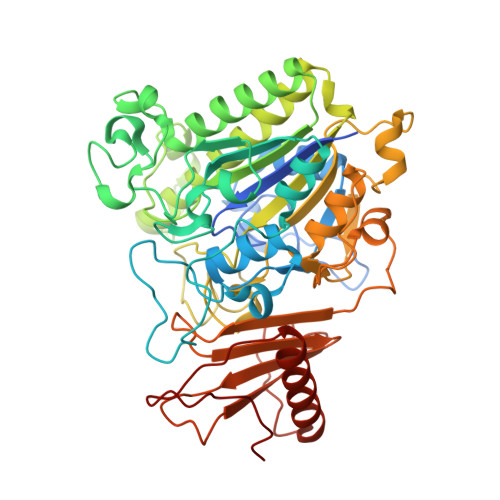Sulfated glycan recognition by carbohydrate sulfatases of the human gut microbiota.
Luis, A.S., Basle, A., Byrne, D.P., Wright, G.S.A., London, J.A., Jin, C., Karlsson, N.G., Hansson, G.C., Eyers, P.A., Czjzek, M., Barbeyron, T., Yates, E.A., Martens, E.C., Cartmell, A.(2022) Nat Chem Biol 18: 841-849
- PubMed: 35710619
- DOI: https://doi.org/10.1038/s41589-022-01039-x
- Primary Citation of Related Structures:
7OZ8, 7OZ9, 7OZA, 7OZC, 7OZE, 7P24, 7P26 - PubMed Abstract:
Sulfated glycans are ubiquitous nutrient sources for microbial communities that have coevolved with eukaryotic hosts. Bacteria metabolize sulfated glycans by deploying carbohydrate sulfatases that remove sulfate esters. Despite the biological importance of sulfatases, the mechanisms underlying their ability to recognize their glycan substrate remain poorly understood. Here, we use structural biology to determine how sulfatases from the human gut microbiota recognize sulfated glycans. We reveal seven new carbohydrate sulfatase structures spanning four S1 sulfatase subfamilies. Structures of S1_16 and S1_46 represent novel structures of these subfamilies. Structures of S1_11 and S1_15 demonstrate how non-conserved regions of the protein drive specificity toward related but distinct glycan targets. Collectively, these data reveal that carbohydrate sulfatases are highly selective for the glycan component of their substrate. These data provide new approaches for probing sulfated glycan metabolism while revealing the roles carbohydrate sulfatases play in host glycan catabolism.
Organizational Affiliation:
Department of Microbiology and Immunology, University of Michigan, Ann Arbor, MI, USA. ana.luis@medkem.gu.se.

















